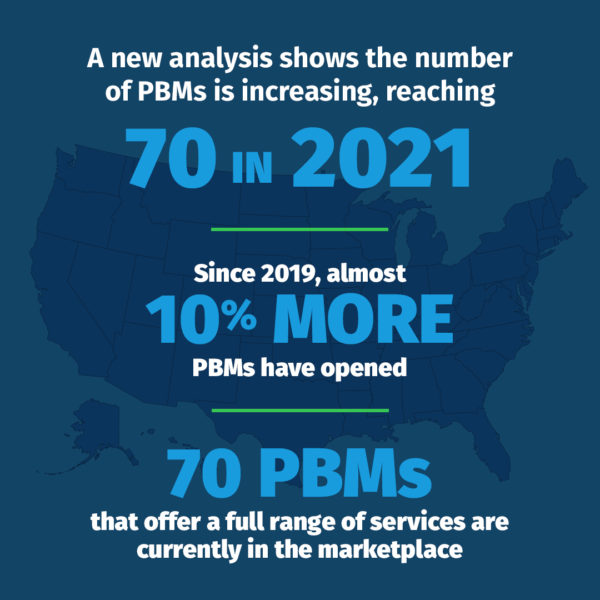Welcome to the Pharmacy Benefit Brief. This brief is your monthly snapshot of news from America’s prescription drug supply chain including pharmacy benefit managers, independent pharmacies, and drug manufacturers.
It’s a Dog Eat Dog World…

As a state legislator or regulator in the health care arena, you understand the importance of competition and its relationship to cost. That’s why we thought it would be helpful to point out new data on the PBM marketplace.
Here’s the bottom line: there are 70 Pharmacy Benefit Managers, PBMs, currently active in the marketplace. And six new PBMs have opened since 2019, an increase of nearly 10 percent.
Take a look at a recent blog post at The Rx Research Corner to get more detailed information on the competitiveness of the PBM marketplace, and why it’s good for payors of health benefits, like employers, and good for patients. PBMs are competing to offer the most innovative, efficient, and cost-effective services to clients.
Did you Know?
It’s important for states to focus on prescription drug prices because, for too many Americans, drug costs are unaffordable, and that’s unacceptable. Unfortunately, special interests, like the independent pharmacy lobby and Big Pharma, are powerful and often wield influence that can lead to harmful policy proposals that do the opposite of lowering prescription drug costs.
This year, some states are considering bills that would impose restrictions on the things PBMs do to keep costs down, all while boosting the profits of special interest groups.
$1 billion? $7 billion? Believe it or not, the following bills will raise Rx costs by eye-popping amounts. Unsurprisingly, all of these bills are strongly backed by the special interest independent pharmacy lobby. The following legislation in these states include provisions that will raise costs:
In Texas, legislation (SB 2195) could cost $10.6 billion over the next ten years and (HB 1919) could cost $4.4 billion over the next 10 years.
- Bill provisions include—Restricting the use of preferred pharmacy networks, specialty pharmacies, and mail-order pharmacies.
In Michigan, legislation (SB 4348) could cost almost $7 billion over the next ten years, in increased prescription drug costs.
- Bill provisions include—restrictions on PBM fees, prohibition of spread pricing, eliminating plan design flexibility, requiring mandated reimbursement levels for prescription drugs, and restricting the use of national accreditation standards.
In Louisiana, legislation (SB 218) was amended, but could have raised prescription drug costs by an estimated $2.5 billion over the next ten years.
- Bill provision included—A fiduciary mandate for PBMs.
In New York, legislation (SB 3762 and AB 1396) could cost nearly $28 billion over the next 10 years.
- Bill provisions include—A fiduciary mandate for PBMs, a requirement to disclose manufacturer and pharmacy contracts, eliminating a PBM’s ability to swap prescriptions to more cost-effective version, and restricting the use of national accreditation standards.
Finally, in Illinois, legislation (SB 2008) could cost over $1 billion.
- Bill provisions include—Increasing dispensing fees paid to pharmacies, expanding Any Willing Provider (AWP) rules, restricting the use of national accreditation standards and preferred network standards, limiting the use of specialty and mail-order pharmacies, and creating a fiduciary mandate for PBMs.
The Latest in Rx News
The latest episode of the Pharmacy Benefit Podcast: Exploring the Impact of the Robinson-Patman Act: Historical Insights and Future Considerations explores how The Robinson-Patman Act has impacted the pharmaceutical market from a historical standpoint, how it might be applied in the future, and what it means for public policy on drug pricing and rebates.
“If the Robinson-Patman Act prohibits price differences, maybe manufacturers, to the extent they’re not able to use rebates to measure market share, just move to a standard level of discount. The more problematic concern is what does that level of discount look like? I think there’s a real concern that that level of discount is much less than the level of discount we see today. What does that ultimately mean? It means higher prices for consumers in the form of both premiums and cost sharing.” Ross Margulies, a Partner with special expertise in Medicare and Medicaid law at Foley Hoag LLP.

